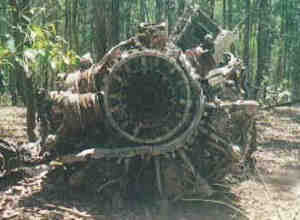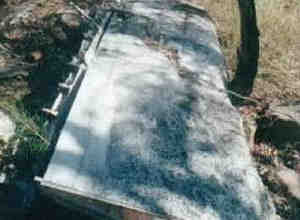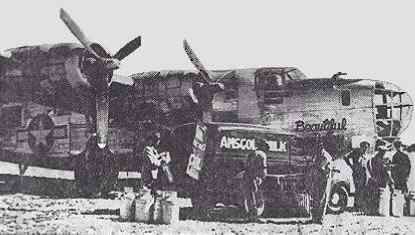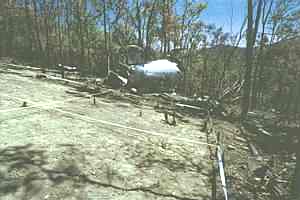The Beautiful Betsy's Discovery.
|
Not until the 25th. July 1994 was the mystery of the Beautiful
Betsy's disappearance solved, forty nine years and six months
almost to the day.
 |
View Southeast toward the coast over the foothills from Kroombit Tops,
in the midsummer heat haze.
On that July day, Queensland National Parks and Wildlife Service were involved in a controlled fuel reduction burn off in the Kroombit Tops State Forest and the adjoining National Park. Kroombit Tops rises almost vertically from the coastal plain some 800 meters to a rouged and inhospitable plateau with deep gullies, higher ridges and is densely forested, covering an area of some 34,400 hectares, 85 Kms West of Gladstone, Central Queensland.
Mr. Mark Roe an Officer with the Parks Service during the burn off stumbled across a propeller with only two of its blades remaining lying where it came to rest almost 50 years before. Moving further on he found the wreckage of what would soon be identified as that of the Beautiful Betsy covering an area of some 150 sq. meters.
 |
On a resent visit to the site with my son Matthew pictured above beside the inverted tail section, a fifty minute drive west of Boyne Island. I found myself standing on the edge of a steep and rugged gully the bottom of which was obscured by tree tops and thick scrub, rising to a heavily forested 2000 foot high ridge on the far side. I could only imagine the final moments of Betsy's flight. She must have only just cleared or clipped that ridge in her fight to regain altitude as reports of the investigators indicate. Looking down all that could be seen of the main fuselage were large amounts of small twisted sections of aluminum clinging to and embedded in the ledges and rocks of the cliff face, as well being scattered about the general area where I was standing. This seemed to indicate to me that the point of impact may not have been to far below.
Behind me was the inverted tail section lying some thirty yards up the gentle but rocky incline of the plateau, which had snapped off and been thrown uphill by the force of the impact. Either side of the tail lay the wings, their buckled condition indicating passage through trees, may be some of it caused on the far side ridge. Further up the slope some one hundred or so yards were the engines, lying where they came to rest.
An investigation lead by Sergeant Randy Brown of the US. Army's Central Identification Unit (CIL), spent the following September of 1994 combing the site for possible remains, any personal belongings of those on board and piecing together what may have brought about Betsy's tragic demise only an hour from her destination, Brisbane.
 |
The starboard wing with tail in background.
A number of theories were put forward as to what may have been the cause of the accident. After my visit to the site, living in the Central Queensland region for the past fourteen years and reading some of the findings of those involved in the investigation, one stands out as the most likely.
At dawn on the 27th. of February, after a long night flight the Pilot found himself in heavy cloud that can hug the rangers in mid summer. He may have descended below what would be considered a safe altitude in a mountainous area with poor to no visibility in an attempt to get a visual of his location and gain his bearings. Emerging from the cloud it was to late. A subtropical low pressure system was recorded in the area on that date; this would lend weight to there being a lot of low lying cloud over Kroombit Tops. The investigators determined from the damage to the four propellers that they had been spinning under high power at time of impact, all the blade tips being bent forward. This also indicated to the investigators a possible nose up attitude at time of impact.
As a Vietnam veteran who spent his share of time airborne, passenger only! I have experienced a few of what could be called 'white knuckled' flights, once on the ground I was quite thankful for the training, skill and experience of the pilots. I can only imagine what those on board would have been feeling in the final moments of Betsy's last flight. As they descended out of the cloud, they would have seen that high ridge up front possibly just clearing or clipping it in their descent. The Skipper pulling back hard with engines screaming in an attempt to climb out of the gully I was staring into. Possibly only another twenty or thirty feet higher and they may have cleared the ridge I was standing on and put the day down to experience.
 |
One of Betsy's four engines lying where it came
to rest almost fifty years ago.
 |
The Starboard Wing Elevator.
|
 |
War time photo of Betsy at Adelaide Airport, S.A.- taking on supplies for the close to home front line of Darwin.
|
 |
 |
The crash site under investergation by the US and Australian team in the September of 1994.
Photos supplied by Ms. Sandra (Sanby) Burns.

